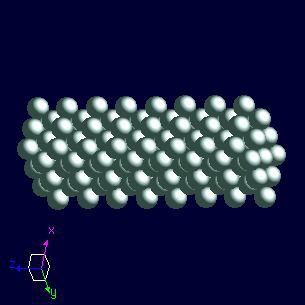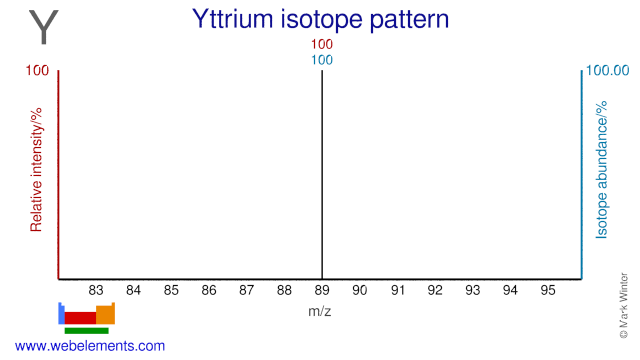Yttrium - 39Y: the essentials
- Name: yttrium
- Symbol: Y
- Atomic number: 39
- Relative atomic mass (Ar): 88.90584 (2)
- Standard state: solid at 298 K
- Appearance: silvery white
- Classification: Metallic
- Group in periodic table: 3
- Group name: (none)
- Period in periodic table: 5
- Block in periodic table: d
- Shell structure: 2.8.18.9.2
- CAS Registry: 7440-65-5
Yttrium atoms have 39 electrons and the shell structure is 2.8.18.9.2. The ground state electronic configuration of neutral yttrium is [Kr].4d1.5s2 and the term symbol of yttrium is 2D3/2.
Yttrium: description
Yttrium has a silvery-metallic lustre. Yttrium turnings ignite in air. Yttrium is found in most rare-earth minerals. Moon rocks contain yttrium and yttrium is used as a "phosphor" to produce the red colour in television screens.

This sample is from The Elements Collection, an attractive and safely packaged collection of the 92 naturally occurring elements that is available for sale.
Yttrium: physical properties
Density of solid: 4472 kg m-3
Molar volume: 19.88 cm3
Thermal conductivity: 17.2 W m‑1 K‑1
Yttrium: heat properties
Melting point: 1799 [1526 °C (2779 °F)] K
Boiling point: 3609 [3336 °C (6037 °F)] K
Enthalpy of fusion: 20.5 kJ mol-1
Yttrium: atom sizes
Atomic radius (empirical): 180 pm
Molecular single bond covalent radius: 163 (coordination number 3) ppm
van der Waals radius: 275 ppm
Yttrium: electronegativities
Pauling electronegativity: 1.22 (Pauling units)
Allred Rochow electronegativity: 1.11 (Pauling units)
Mulliken-Jaffe electronegativity: (no data)
Yttrium: orbital properties
First ionisation energy: 599.87 kJ mol‑1
Second ionisation energy: 1179.40 kJ mol‑1
Third ionisation energy: 1980.30 kJ mol‑1
Yttrium: abundances
Universe: 7 ppb by weight
Crustal rocks: 29000 ppb by weight
Human: (no data) ppb by weight
Yttrium: crystal structure

Yttrium: biological data
Human abundance by weight: (no data) ppb by weight
Yttrium has no biological role.
Yttrium: uses
Yttrium: reactions
Reactions of yttrium as the element with air, water, halogens, acids, and bases where known.
Yttrium: binary compounds
Binary compounds with halogens (known as halides), oxygen (known as oxides), hydrogen (known as hydrides), and other compounds of yttrium where known.
Yttrium: compound properties
Bond strengths; lattice energies of yttrium halides, hydrides, oxides (where known); and reduction potentials where known.
Yttrium: history
Yttrium was discovered by Johann Gadolin in 1794 at Finland. Origin of name: named after the village of "Ytterby" near Vaxholm in Sweden.Yttrium: isotopes

Yttrium: isolation
Isolation: yttrium metal is available commercially so it is not normally necesary to make it in the laboratory. Yttrium is found in lathanoid minerals and the extraction of the yttrium and the lanthanoid metals from the ores is highly complex. Initially, the metals are extractedas salts from the ores by extraction with sulphuric acid (H2SO4), hydrochloric acid (HCl), and sodium hydroxide (NaOH). Modern purification techniques for these lanthanoid salt mixtures involve selective complexation techniques, solvent extractions, and ion exchange chromatography.
Pure yttrium is available through the reduction of YF3 with calcium metal.
2YF3 + 3Ca → 2Y + 3CaF2
